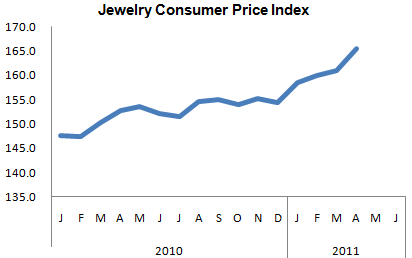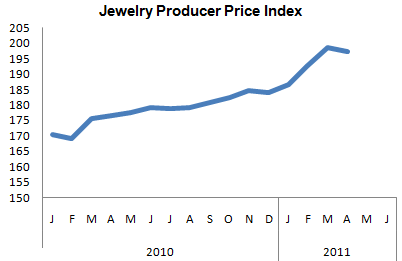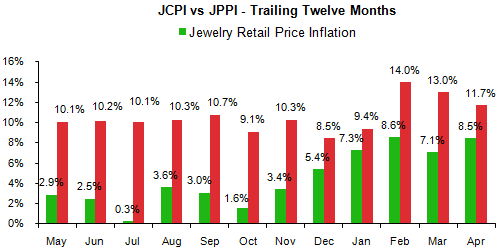IDEX Online Research: Jewelry Producer Prices Pause in April
May 24, 11
(IDEX Online News) - Jewelry producer prices slipped modestly in April, when compared to the prior month, due primarily to leveling costs of precious metals used in jewelry manufacturing.
The full analysis is available to IDEX Online Research subscribers and IDEX Online members here.
However, based on recent price action of those commodities, April’s decline in jewelry producer prices is probably just a pause in an otherwise long-term increase in precious metals prices. While platinum prices in May are down about 5% from their peak, gold continues to flirt with $1,500 per ounce in May, record territory for this precious metal.
Because price changes travel through the distribution pipeline on a delayed basis, jewelry consumer prices continued to rise. Retail jewelers’ prices reflect higher costs incurred from suppliers over the past year, since retail jewelers’ inventories turn about one time per year. Thus, we expect retail jewelry prices to continue to rise over the near term.
Despite a pause in producer price inflation in April, jewelry price inflation is running dramatically above historic trends, both at the retail level and at the supplier level.
The graphs below summarize trends in both the Jewelry Producer Price Index (JPPI) and the Jewelry Consumer Price Index (JCPI).
  Source: BLS |
What is behind the recent price inflation? The primary driver has higher precious metals and diamond costs. Over the past year, gold prices are up by more than 28%, while polished diamond prices are up nearly 14%. Currently, both gold and polished diamond prices are at or near record levels, and appear to be headed higher.
A multiplicity of factors is driving precious metals prices higher, especially gold. In part, investors are still seeking a “safe harbor” for their currency, especially since the value of the U.S. dollar has been eroding over the past year. Further, a recovery in the global economy is pushing up demand for gold used in the production of goods. And, finally, financial speculators are causing some of the pain.
Polished diamond prices are rising due to mining capacity constraints in the face of sharply stronger demand from consumers in China and India, as well as a moderate recovery in demand from U.S. shoppers.
In April, watch producers’ prices participated in the inflation flames that have been whipping the jewelry industry, similar to trends in March. In prior recent periods, there has been virtually no watch price inflation.
The table below summarizes inflation in the U.S. jewelry industry for the month of April 2011.
| Inflation Component | April 2011 vs April 2010 | April 2011 vs March 2011 |
| Retail – All Jewelry & Watches | +8.5% | +2.9% |
| Retail Jewelry | +9.6% | +3.3% |
| Retail Watches | +1.1% | (0.3%) |
| Supplier – All Jewelry & Watches | +11.7% | (0.7%) |
| Supplier – Precious Metal Jewelry | +11.7% | (2.3%) |
| Supplier – Watches | +2.4% | +2.7% |
One bit of good news: retail jewelry prices in the first four months of 2011 have been rising much faster than in the past, so the gap between retail and supplier prices is closing, though very slowly. It is clear that jewelry retailers are no longer willing to absorb margin-robbing supplier price increases.
The graph below summarizes the historic disparity between retail jewelry price inflation and suppliers’ jewelry price inflation. Beginning in November 2010, retail prices (green bars) began to rise. By January 2011, retail price inflation was closing in on supplier price inflation – retail merchants were finally passing along higher costs to consumers. In February, supplier prices spiked, followed by another surge in March and April, as the graph illustrates.

Source: BLS
Outlook: Inflation Is Here, Until the Price Bubble Bursts
Are prices headed higher because of real demand created by a recovering economy? Alternatively, are merchants pushing prices higher in an effort to recover sales and profits lost during the recent recession? If it is the former, inflation is here to stay. If it is the latter, a price bubble is forming, and it will burst. When prices rise as quickly as they have recently, our sense is that there is potentially a price bubble.
In the U.S., Federal Reserve officials are watching inflation closely. Most of the Fed’s governors have agreed to end the stimulus programs and let interest rates rise, in hopes of keeping inflation low. The problem is this: 2011’s inflation numbers, both for the jewelry industry and other industries, indicate that inflation is real. In short, it appears that merchants in all sectors are trying to recoup margins – hopefully, not at the wrong time, just as the economy is getting on solid footing.
The full analysis and statistics on jewelry industry inflation for April is available to IDEX Online Research subscribers and IDEX Online members here. Click here for more information on how to subscribe or become a member.